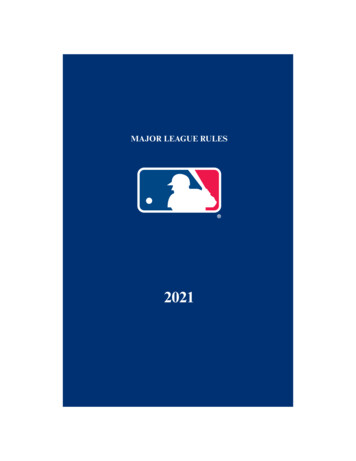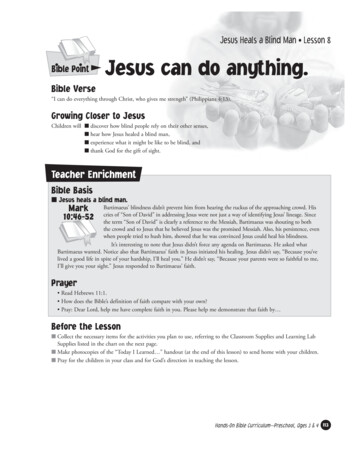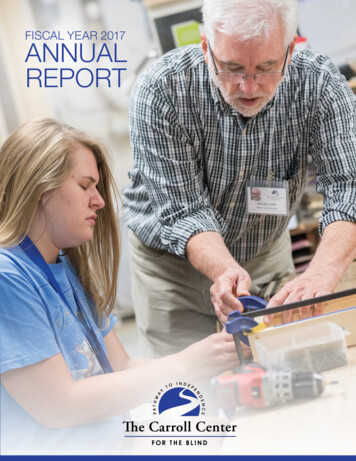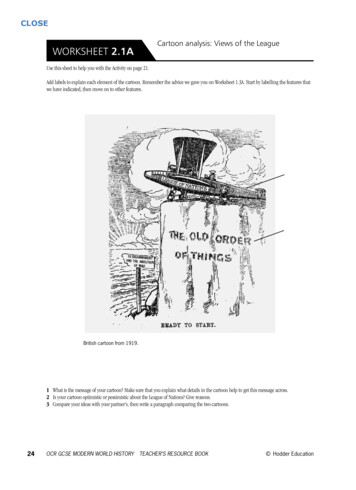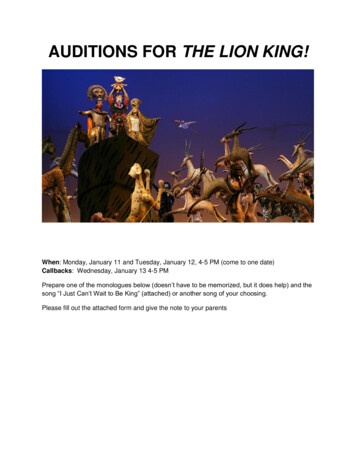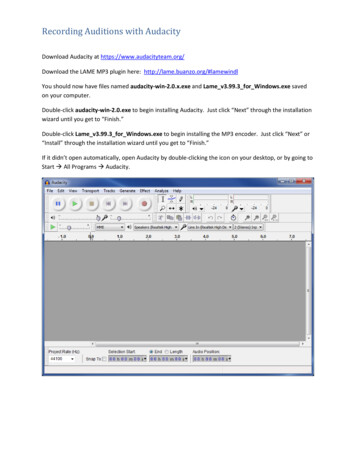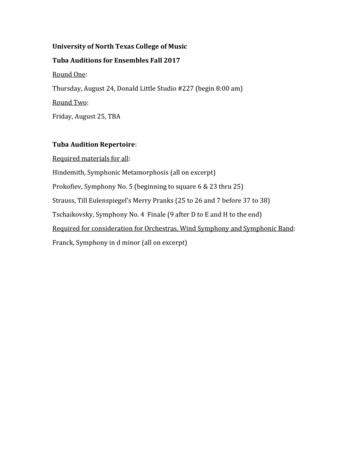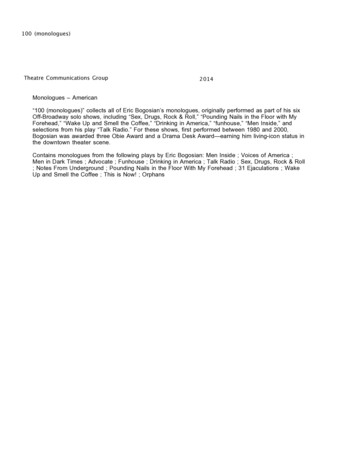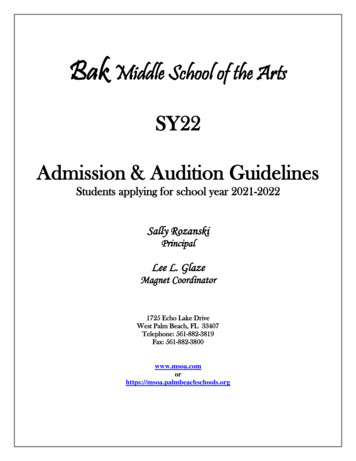
Transcription
Rethinking Blind AuditionsBlind auditions, in which musicians perform behind a screen to shield their identity,were instituted to redress the longstanding exclusion of people of color and women fromorchestras. Blind auditions were successful in some regards, but the percentage of Black,Indigenous, and People of Color musicians has not risen significantly over the years. Isit time to rethink blind auditions? Here, Afa Dworkin moderates a discussion in whichseveral Black musicians offer their views on where things stand now, share their livedexperience, and suggest new ways to approach the audition process to create more diverse,equitable American orchestras.Discussion moderated by Afa Dworkin.Starting in the 1970s, American orchestras implemented “blindauditions,” whereby screens concealed musician candidates fromthe audition committee and promised anonymity. The impetusfor blind auditions was to address orchestras’ enduring racial andgender disparity: most orchestra musicians were White men. Byeliminating visual characteristics such as race and gender, blindauditions meant that a musician’s artistry became the central consideration, and that in turn would lead to greater representationand hiring of long-excluded musicians. Orchestras would lookmore like the communities they served.However, it should be acknowledged at the outset that the term“blind auditions” is a misnomer, since very few orchestras haveengaged in truly blind auditions. Most orchestras have a processwhich determines a musician’s readiness for an audition basedupon the individual’s resume and, more importantly, the vast majority of orchestras eliminate the screen during the later rounds ofthe process, thus introducing direct opportunities for bias.Until blind auditions, auditions were held as they are for actors,singers, dancers—you saw exactly who was auditioning. Whenpositions opened at orchestras, conductors often handpickedplayers in advance. Frequently, even learning about auditionsdepended on word of mouth, and knowledge of opportunitiesAFA DWORKIN: Though this conversation is about blind auditions, I hope thatwe look at it more broadly, rememberingthat blind auditions are only a methodtoward creating a more representative,more vibrant, more diverse, and richercollective that is the orchestra of tomor-20belonged to a self-reinforcing network. Musicians’ unions weresegregated until the federal government ordered the merger ofBlack and White unions in 1967. Some adjustments were madeto blind auditions along the way: carpeting was installed whenpeople realized that the sound of women’s shoes indicated gender.But despite the name, the process was never entirely blind.Particularly in terms of gender, blind auditions changed theface of orchestras. In 1970, according to a 2000 Harvard study,women comprised about 6 percent of musicians at some largerorchestras. In 1978, according to the League of American Orchestras’ 2016 Racial/Ethnic and Gender Diversity in the OrchestraField study, the percentage of women musicians at orchestraswas 38.2 percent, and in 2014 women comprised 47.4 percent oforchestra musicians. The League study reported that the percentage of musicians with Asian/Pacific Islander backgrounds rosefrom 5.3 percent in 1980 to 9.1 percent in 2014. However, thepercentage of musicians identified as African American/Black in2014 was 1.8 percent, and 2.5 percent identified as Hispanic/Latino. Those percentages had not significantly increased over time,and they have risen only marginally since. Orchestras continue tobe among America’s least racially diverse institutions.Is it time to reconsider blind auditions?row. While they are a central piece relativeto the enduring lack of representation inorchestras, auditions are merely a meansto an end—a method or a process—for anintended result.Alex, what other adjacent or equallyimportant and tangible actions need to beconsidered when we’re visualizing our endgoal of creating and building an artisticcollective that is an American orchestratoday or tomorrow? Should we be focusing on blind auditions as much as we havebeen, and are there equally important elements that contribute to a lack of progresssymphonySPRING 2021
ABOUT THE SPEAKERSand could turn us around?ALEX LAING: The screen is a tool,not a system. I’ve been fortunate to get towork with my brother Justin Laing in hisconsultancy, Hillombo. Through that workI’ve gotten introduced to a lot of things,in particular a way that Justin sometimesbrings the work of Donnella Meadows,Ibrahm X. Kendi, and the Heifetz andMinsky “Adaptive Leadership” frameworkinto dialogue with each other.All three of those sources would saythere’s no such thing as a broken system,and the results that we are seeing in termsof hiring and auditions are the outputsof a system operating correctly—thoughthe stated intention of the system mightbe otherwise. Donella Meadows wrote aIf we’re looking for differentresults, we have to be doingthings differently, ourmethodology must change.–Afa Dworkinpiece called “Leverage Points: Places toIntervene in a System,” in which she saysthat the most impactful place to intervenein a system is at the level of mindset. Ifthe question about auditions was, whereshould we be focusing in order to cascadethe biggest difference in the system,believing that the system is operating correctly for itself right now, I would locatethe screen as being towards the marginsof this system. It’s a tool that relates tothis question of “diversity in orchestras,”but where there’s a need for attention—inaddition to looking at the tools and thetechniques and the procedures—is aroundour mindset. What’s the aesthetic ormindset argument for this and how doesthat show up?DWORKIN: Perhaps the focus needsto be on how orchestras want to seethemselves, how they act as inclusivebodies that intentionally attract musiciansof color so that what they offer is a richer,more diverse, more representative versionof themselves. How to get there dependson whether they do the right work at theonset.americanorchestras.orgJennifer Arnold joined the Richmond Symphony as Director ofArtistic Planning and Orchestral Operations in the fall of 2019 tofurther her work in increasing representation on orchestral stages.She spent fifteen seasons as a violist with the Oregon Symphony andserved as Director of Artistic Operations for 45th Parallel chambermusic collective in Portland. She is a faculty member of the SphinxPerformance Academy and a violist with the Gateways Festival Orchestra, SphinxSymphony, Chineke!, and the community engagement quartet mousai REMIX.Arnold is a member of American String Teachers Association, Suzuki Associationof Americas, American Federation of Musicians, and Urban League, and enjoysvolunteering, mentoring, karaoking, and traveling. Follow her on most social mediaplatforms @24caratviola.Afa S. Dworkin is a musical thought leader and cross-sectorstrategist driving national programming that promotes diversity inclassical music. She serves as President and Artistic Director of theSphinx Organization, the nation’s leading organization transforminglives through the power of diversity in the arts. She designed and builtSphinx’s programming since its inception, which included creatingmore than 100 partnerships worldwide. A frequent speaker and writer on racialequity in the arts, Dworkin has written for the New York Times and Strings Magazine,and has spoken at events at the League of American Orchestras, Chamber MusicAmerica, and ICSOM, among others. A trained violinist, she is on faculty at RooseveltUniversity’s master’s in arts administration program.Jeri Lynne Johnson founded Black Pearl Chamber Orchestra in2008 as a model for the 21st-century American orchestra. In its brieftime, the Philadelphia-based Black Pearl has emerged as a powerfuladvocate for artistic excellence and racial equity in classical music,winning numerous grants from the National Endowment for the Arts. In2015, Johnson created DEI Arts Consulting to share her strategic andcreative solutions for cultural institutions. As a conductor, Johnson was awarded theTaki Alsop Conducting Fellowship in 2005. She has since broken barriers in Europeand the U.S. as the first African American woman on the podium for many orchestras,and has conducted the Philadelphia Orchestra, Dallas Symphony, the BournemouthSymphony (U.K.), and the Weimar Staatskapelle (Germany), among others.Alex Laing, principal clarinet of the Phoenix Symphony, is a nationallyrecognized instrumental artist, speaker, and thought leader whose workrepresents a modern take on orchestral practice. He was recently asoloist with the Sphinx Virtuosi at Carnegie Hall, and has collaboratedon Tyshawn Sorey’s Cycles of My Being, in Thomas Hampson’s Songof America: Beyond Liberty project, and as a member of GatewaysFestival Orchestra. Laing has spoken at the conferences of theAssociation of British Orchestras and the League of American Orchestras and, asa teacher, has partnered with the Los Angeles Philharmonic’s Youth Orchestra LosAngeles and the National Youth Orchestra of the United States of America (NYO-USA).Violinist Melissa White has performed around the world as asoloist and a chamber musician. She makes her debut this seasonwith the Cincinnati and Albany (NY) symphony orchestras; pastengagements include the Cleveland Orchestra, Boston Pops,Louisville Orchestra, and the Atlanta, Baltimore, Colorado, Detroit, andPittsburgh symphony orchestras. A first-place laureate in the SphinxCompetition, she is a founding member of Harlem Quartet, with whichshe has performed and engaged in educational activities throughout the U.S. andinternationally since 2006. A native of Michigan, she holds degrees from the CurtisInstitute of Music and New England Conservatory.21
LAING: It’s about mindset. You coulduse a screen and have an orchestra madeup entirely of Black women, and youcould not use a screen and have an orchestra made up entirely of Black women.The real determinant in that would beyour mindset, in terms of why you wantthat result and what that is about for youartistically, as an ensemble. Mindset iswhere I think there’s the opportunity tocascade change. Because of the work Iget to do with my brother, I was able todeliver a provocation for the Associationof California Symphony Orchestras whereI riffed on this question of paradigm andmindset, and how you answer the questionof “for what purpose?” For a symphonyorchestra, if the answer to that “for whatpurpose” question necessitates having amore diverse orchestra, then you wouldhave a more diverse orchestra. You wouldeither use a screen or not use a screen inpursuit of that.DWORKIN: Jeri, could you discussyour view on why we haven’t been able toevolve our mindset heretofore—not to anymeasurable extent where we could say thatthe difference was made by way of havingorchestras be more representative on asystemic level. Could you reflect on whatmight stand most significantly in our way,and also the role of blind auditions relativeto that.JERI LYNNE JOHNSON: Alex andI first met at the Shift Festival in D.C.at the Kennedy Center, and the speechthat I gave there was about transformingthe paradigm. To me, language is a veryimportant indicator of people’s thoughtprocesses. One of the points I made inthat speech is that, when we speak aboutdiversity in future terms, that speaks asthough diversity is not a feature of reality.Diversity is a fact. The sooner that orchestras begin to deal with the fact of diversity,that will help shape mindsets about whatthey do. Diversity is not an endpoint thatdescribes a set of fixed variables. Diversitydescribes the relationships between members of a living system, whether it’s anorchestra, a school, a society. To the extentthat relationships between the membersof those living systems continue to change22and evolve, the process of achieving andmaintaining diversity is a lifelong coreoperational process. Blind auditioning, thescreen, is a tool, not a system.Maintaining and achieving diversitywithin a living system is a constantlyshifting target that doesn’t stop after oneor two years. There are no reductionist, external methodologies or practices or toolsthat will achieve something permanentlyand finally. It is a living system, and thisis the way that people have to think abouthow you adapt your organization. This isan adaptive strategy for not just survivingThe screen is a tool, not asystem. Mindset is where Ithink there’s the opportunityto cascade change. –AlexLaingthe moment politically, but for thrivingwithin society as a functioning part of ademocracy as an arts institution. Goingback to mindset: understand that diversityis a fact of reality. Starting with that fact,what do you do?DWORKIN: The biggest hurdle forour sector to overcome is the unfortunate myth that whenever we speak aboutrepresentation or diversity or inclusion, weneed to succumb to a compromise relative to artistic merit and need to expect alesser standard. This tale is long overduefor being eliminated and combatted. Thereis no lack of talent, not even a lack ofpreparedness. There is a respectable rosterof qualified, poised, incredibly talented,and prepared musicians of color. Whatwe have lacked is true change, becauseorchestras have not prioritized it.There seems to be now a greater volumeof conversations among orchestras, to beprecise the 103 orchestras that partnerwith the National Alliance for Audition Support [a collaboration amongthe Sphinx Organization, New WorldSymphony, and the League of AmericanOrchestras]. That conversation seems tobe about: we’re ready to do something differently, let’s develop new methodologiesand new ways to prioritize this so thatwe can come out of the pandemic andset a different tone relative to diversity inorchestras. My biggest objective, personally and professionally, is to make surethat when we look back on this year ofGeorge Floyd, of Breonna Taylor, of triplepandemics, we don’t say to ourselves, great,we’ve created more diversity committees,engaged a few keynote speakers of color,and are now centering the work of Blackand Brown artists a couple of times ayear, rather than once. Let’s not permitourselves a reality where our stages anddecision desks go without tangible change.What can we tell orchestras to do ornot to do, so that when we get back onstage we can be proud of our efforts? Howdo we begin to see a real shift of what isboth on stage and behind the stage?JOHNSON: It’s critically importantto involve everyone in the process. Thesecan’t be externally driven; they need to beinternally motivated projects and activities. That’s not to say that there aren’t toolsand resources and strategies where weleverage inflection points in the system.It’s about how we do it in a much morenuanced and conscientious manner. Forexample, everybody is focused on fellowships, which are an important tool, butfrom the standpoint of getting peopleactively engaged in this work, we needto go beyond fellowships into creatingmentorships that are inclusive mentorships, not just diverse mentorships. WhatI mean is that there is a more reciprocal relationship between a mentor and amentee, where everybody can learn fromeach other, where the flow of informationand experience and insight is not unidirectional. Young people or new peoplecoming into orchestras have insights andexperiences and points of view that are ofdeep value to an orchestra as we continueto maintain relevance and survive in a newera. These are the kinds of relationshipbuilding that go beyond simply attracting people of color to the artform or aparticular organization to maintaining anddeveloping them long-term.DWORKIN: I have been a bit moreencouraged this year by hearing membersof orchestras who are allies but not necessymphonySPRING 2021
sarily musicians of color talk about howthey want to help their orchestra get there.There’s more of that spirit of activism anda desire to do something differently. We’recoming to terms with the fact that if we’renot asking ourselves for different results,we cannot follow the same methodology—it’s just not logically possible. Howdo we instill a sense of accountability?JOHNSON: Democracy is everybody’sresponsibility. There are many differentways of accountability. I don’t know thatthere’s any one point in a system thatwe can point to and say, this is where weshould be accountable. I think all peoplewho believe in this work and want toundertake this work and see change—it isup to all of us. That doesn’t mean we’re allresponsible for all the change, but we areresponsible for ourselves and for our rolesin this process to whatever extent we feelcomfortable and compelled to engage inthe process. Everyone can do something.When we talk about diversity, equi ty, and inclusion, the inclusion part oforchestral culture is critically important.We should empower people at every levelof the organization, whether it’s orchestramusicians, librarians—who are also musicians—in the orchestra to feel empoweredto engage this work and to feel that theyhave something to contribute. Inclusionisn’t just inclusion from the standpoint ofvisual diversity and representation, it isincluding everyone and encouraging themto join in this process of change.JENNIFER ARNOLD: There are twovery different conversations that we’rehaving. The first conversation is aboutthe actual audition process in its currentform. I think that if you did a fair, fullyblind audition—meaning invite people,stop leaving people out, don’t pre-advanceanyone, and have the screen up for threerounds—I believe an orchestra could actually be more diverse right there, withoutchanging too much of the process. If thatcomes from an honest place, if orchestras are honest about how musicians arehired and eliminate certain things, youwill see a more diverse orchestra withouteven changing some of the things thatpeople are talking about in this industry.americanorchestras.orgIt’s important that musicians are honestabout how they got their job, and maybethat was the way we used to do it becausethat’s the way our teachers did it. Butwe’re in 2021, we want a different typeof orchestra that includes everyone, andthose policies won’t work anymore. Fullyblind auditions with screens up, pre-advancement removed, and an open auditionwill help tremendously.That said, in 2021 and moving forward,the job requirements and qualifications aredifferent for orchestra musicians. Reevaluating the whole process and the job—I’mall for that. The bare minimum at thispoint is that the screen should be up, andwe should remove pre-advancements.Pre-advancements are in all the contracts.I’m going through contracts right now forall kinds of orchestras, from the smallbudget to the largest-budget orchestras,Diversity is a fact. The soonerthat orchestras begin to dealwith the fact of diversity, thatwill help shape mindsets aboutwhat they do. –Jeri LynneJohnsonand there’s always a way to get in anorchestra without even auditioning. That’sa problem.DWORKIN: Many professionalmusicians of color in American orchestras have shared that having a fully blindaudition from the very beginning to thevery end, and giving everyone who wishesto audition an opportunity, will improvethings right off the bat. We should alsochange our mindset. It’s long overdue forus to begin envisioning ourselves as morediverse organizations. Relative to thejob description of an orchestral musician today, what do you think about thepossibility of establishing a committee ofprofessionals who assess the fitness of amusician that goes beyond their abilityto play an excerpt? As in, their abilityto serve as a strong ambassador for themission of that orchestra, their ability torelate to the community which it serves orin which it resides, their communicationskills, their talents as a teaching artist. Allqualities and skillsets would be assessedin addition to one’s ability to play threeminutes of Don Juan excerpt. Those wouldbe considered when trying to ascertainsomebody’s readiness to join an orchestra.Do you see it as sensible, realistic?ARNOLD: That’s great. However, mybiggest issue would be that if you see theperson, biases come in. Particularly if it’san interview process before the screencomes down, which it would be. I’ve beeninterviewed for finals, and the questionsthat were asked—some were inappropriate. “How old are you?” and “Where doyou see yourself in five years?” Those questions shouldn’t be asked.My own experience makes me thinkabout that. Whatever method we use tokeep auditions as blind as possible wouldbe great, and once a job is offered, thenmaybe the ability to speak in front of anaudience, work with young people, playnew works, are rolled into the tenureprocess. Or maybe there’s a question about“please list your experience with community engagements” that won’t take awayfrom the blind process. I don’t want inherent bias affecting the outcome.MELISSA WHITE: I have beenthinking about who learns about auditions and when invitations are given out,because auditions are maybe not so widelyadvertised. Who is getting invitationsto audition, who are they coming from?When we think of diversifying what anorchestra looks like, we should also thinkof diversifying who we are getting theword out to. When auditions come upand an orchestra is thinking of who theywant to reach, where are they going toreach people? Conservatories oftentimeshave wonderful musicians, but so douniversities with music programs. A lotof times, smaller schools aren’t told aboutauditions. Students and young musiciansdon’t necessarily know where to look orwho they should be talking to about theseopportunities. When word gets out onauditions, it’s important to diversify wherethat announcement is made and who itgets to.As musicians, we talk a lot about em-23
bracing our individuality. Once musiciansjoin an orchestra, of course it’s importantthat the individuality is the orchestra. Butthe orchestra is made up of individuals,and musicians oftentimes are multifacetedin what we excel in. What if orchestrasstarted to embrace that and allow musicians to show their fullness in whateverthat may be? Once auditions are doneand perhaps on the tenure track, askingmusicians what skillset they add to thisbody becomes part of the conversation. It’sexciting—perhaps someone wants to seethis orchestra because a certain musicianis in it and the musician excels at improving, so that’s worked in. Even if it’s notin a concert, but in some way allowingmusicians to continue growing in theirmultifaceted personalities and letting thatshine through.DWORKIN: It’s an opportunity fororchestras to consider musicians joiningtheir ranks as individual artists who addsomething artistically and culturally tothe collective. Understanding and caringabout that seems like it would be a naturalthing. Particularly for today’s generationof artists, millennials and onward, anindividual musician may become a pointof attraction that encourages them toconsider a pathway into an orchestra—ifthey know that’s valued.ARNOLD: A couple of major concertmaster auditions are coming up. Individualism and what a musician is in the21st century have been on my mind. I wasthinking about auditions and repertoire,still having violas play Bartók, Hindemith,and Walton at auditions. You could haveMozart concerti or solo Bach in a round,of course, but why not also let musiciansdecide what they’re going to play for theiraudition, maybe for their solo piece, forone round. If someone picks a solo pieceby Jessie Montgomery or Valerie Coleman, you’ll see who is inclusive. Someof the orchestras that are talking aboutauditions right now are not changingrepertoire to show what they want to be,who they want musicians to be, and whatthe organization is about for the future. Ifyou want more diverse people to come toyour audition—beside recruiting, which24I think is the number one thing—peopleare not going to show up if your orchestrais not publicly putting it out there that it’sinclusive.DWORKIN: Let’s talk about repertoire. For the past decade, I have spenttime as part of the Sphinx Organizationencouraging and cajoling and shamingorchestras into diversifying what is puton stage, and encouraging folks to simplyopen up and make themselves interestedin an incredible volume of works by livingand historical Black and Brown composers. There’s no lack of excellent literature.Statistics from the League of AmericanIf you did a fair, fully blindaudition—stop leaving peopleout, don’t pre-advance anyone,and have the screen up forthree rounds—I believe anorchestra could be morediverse right there. –JenniferArnoldOrchestras a few years ago tell us that lessthan 1 percent of all literature performedby American orchestras as part of mainsubscription series is by people of color.That’s hardly a milestone. We have beenseeing encouraging season announcements, and it’s terrific that some of thesedeserving works are beginning to beprogrammed. How do we encourageorchestras to embrace that, recognize thewealth that’s here already and the beautyand excellence inherent to these works byBlack and Brown composers, and make ita consistent practice to have the repertoirebe reflective of the rich diversity in ourcommunities?ARNOLD: A lot of people have beenreaching out to ask for my list of BIPOC[Black, Indigenous, and People of Color]composers and artists. I refer them to musicbyblackcomposers.org, composerdiversity.com, or boulangerinitiative.org. Peoplein the industry need to take time, just likeI have, and sit, listen to music, get to knowcomposers, get to know artists. At thelast in-person SphinxConnect, I handedmy card to composers. I said, “I’m JenArnold, I’m at the Richmond Symphony,I’d like to know who you are.” That’s nota promise to commission anyone, it’s justintroducing myself. When we’re talking about auditions and how to diversifyeverything, the whole industry needs tohave a restart. We do things because we’vealways done them that way, and it’s timeto stop that. People in the programmingindustry need to put themselves out thereinstead of having people come to us.There’s also a conversation that peopleare uncomfortable having, about BIPOCcomposers versus women composers.Maybe orchestras are doing better incorporating women, but if all your womencomposers and all your women conductorsare White, are you really diversifying yourseason?JOHNSON: I would look at the issueof the brand of an orchestra writ large inthe general public’s mind. Your ability toprogram composers of any kind goes backto what your brand is. Is your brand “weare all about the past,” or is your brand“we are all about the now”? Is your brandexclusion or is your brand belonging? Tothe extent that your brand strength as anorganization is such that no matter whatyou put on your program, your audience isdown for whatever you’re doing, you canbe as bold as you wish in your programming.DWORKIN: Simply changing something for a season won’t make a difference.However, redefining who we are to ourcommunity will. That takes initiative andrisk taking, but we’ve seen how in a digitalage, enforced by COVID, we’ve beenflexible and agile. We’ve done things thatwe thought would never be possible in adigital space. Orchestras are reimaginingthemselves. We could and must do thesame thing by reimagining ourselves froma cultural and a diversity standpoint.WHITE: In this new virtual realm, wecan change the concept of public relations and what orchestras send when theywant to get the word out for an upcomingprogram or season. Love it or hate it, social media is out there. Why not use thatfor people to get to know the artist, whatthey’re listening to, what they’re watchingsymphonySPRING 2021
that inspires something they write if it’sa composer. What were the transformative performances they gave or saw thatsparked inspiration? What if a PR kitincluded more of that sort of information, so before you go you get a little bitof acquaintance? It doesn’t have to beexpensive; it can be accessible to anyonearound the world. It’s starting to make ourworld smaller with what we have at hand,and what we use anyway. Then it’s not likepeople are coming to hear a stranger on aprogram.LAING: I’m thinking about the constraint that Ibram X. Kendi’s frameworkplaces on us around racism and antiracism, and the unavailability of the optionof “not racist.” We’re looking at orchestrasat the level of mindset and asking, arewe racist or antiracist? If we were to saythat we are aspiring to be antiracist asour mindset, what actions, behaviors, andindicators flow from that? Auditions,repertoire, where the hall is located, realestate, relationship to community, theindicators so you know that you’re doingthe work. There was a piece by ProjectZero at Harvard called “The Qualities ofQuality” about how you define excellencein the first place. That piece was aboutarts education, but the idea travels. Areyou defining excellence in a way such thatyou could have an American orchestrathat didn’t include Black music and Blackmusicians and call it excellent?BJ Fogg [behavioral scientist at Stanford University] has a model for behaviorthat says, “Behavior is what happenswhen motivation, ability, and a prompt allcome together.” What we’ve seen to thesurprise of a lot of us is how the behaviorof orchestras around programming haschanged dramatically in the last eighteenmonths. Did we gain some new ability?I think that what we got was a promptand some motivation that then allowed usto access the ability that we already had.With auditions, maybe we should spendour energy imagining what would need tochange for different behavior in hiring—that’s what we are really looking for.ARNOLD: A conversation I have atthe Richmond Symphony is that in everyamericanorchestras.orgthing we do, we think about how something looks to the BIPOC community. Ifrepertoire for your auditions is not diverse,that’s a problem in 2021. Audition repneeds to be looked at, and I don’t meanjust t
Rethinking Blind Auditions Starting in the 1970s, American orchestras implemented "blind auditions," whereby screens concealed musician candidates from the audition committee and promised anonymity. The impetus for blind auditions was to address orchestras' enduring racial and gender disparity: most orchestra musicians were White men. By

